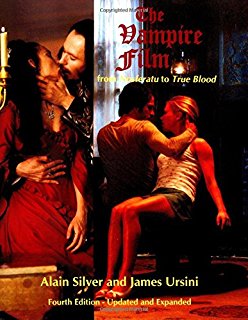Authors: Alain silver & James Usini
First published: 2011 (4th Ed)
Contains spoilers
The Blurb: This newest edition will track the form's evolution from such 1970s reinventions as Count Yorga Vampire and Blacula, The Hunger and Vampire's Kiss in the Eighties, Interview with the Vampire, Bram Stoker's Dracula, and the Blade series in the Nineties, through 30 Days of Night, I Am Legend, and the Underworld series in the first decade of the 21st century. All these films plus celebrated international examples such as Thirst and Let the Right One In and the hit television series Buffy the Vampire Slayer, New Amsterdam, Angel, The Vampire Diaries, and True Blood are covered in this long-awaited, completely revised, expanded, and redesigned fourth edition that follows the vampire figures, both male and female, through the millennium and beyond.
The Review: Let us start with the blurb. To be fair the blurb I quoted was not from the rear sleeve but from Amazon. Imagine my shock when I saw a series, New Amsterdam, I had not heard of… even more shocking as I had just read the book. The book does not mention the series and, from what I have been able to ascertain, New Amsterdam is a police procedural with a main character who is immortal. He has a rare blood type but there is no vampiric aspect that I can discern. Why it is in the blurb I cannot tell.
I saw someone post on Facebook that this was the best vampire reference book out there. It is a revised 4th edition (the first edition being published in 1976). It is not the best vampire film reference book out there but it isn’t bad, at all.
There are a few glaring errors. When the book was first written, it was hot on the heels of In Search of Dracula and so I can understand the conflation of the character Dracula and Vlad Ţepeş. That has been fairly and squarely debunked down to 'Stoker borrowed the name and a tiny amount of biographical data' and I would have liked to have seen that reflected in this edition (even if it was to refute it). But glaring additions such as Stoker including native earth as a trope (here’s a clue, he didn’t) show that the source material was not well known by the authors. Indeed they also include original sources such as “Vampire of the Fens”, which is known to be a hoax.
Whilst I would like to point out that Homer in Near Dark was a child and not a dwarf as suggested and that the entry on the Nostradamus Series seemed oblivious to the fact that the four films started life, in Mexico, as a serial and therefore the entry lost some of its sense, I do have to say that the errors, whilst there, are not endless and there is much goodness to be drawn from the pages.
However the book has two flaws. Firstly the way it has ordered things is idiosyncratic, to say the least, though I think this is mostly bound to it being revised over the decades. It is indexed, however, and this does help. The other thing is that it is not particularly in depth in its analysis – and again, given its very broad remit and the fact that it isn’t necessarily aimed at academia, allows for that. I was a little taken aback by guest entries, sometimes inserted article like into chapters, rather than the authors adding certain entries into the main text – the entry for True Blood was done in such a way, written by Linda Brookover and tagged onto the end of a chapter (in this case). These sections are printed with red text, rather than black.
It is nicely illustrated, in colour, throughout and does actually pick up on some of the more obscure and indie titles. There is a nice filmography at the end of the book.
So a few errors, a strange layout, but nicely illustrated, covering some obscure titles and worth a look. 6.5 out of 10.
Wednesday, January 11, 2017
The Vampire Film: From Nosferatu to True Blood Fourth Edition - Updated and Expanded - review
Posted by
Taliesin_ttlg
at
10:18 AM
![]()
Labels: Carmilla, Dracula, Erzsébet Báthory, nosferatu, reference - media, undead, vampire, Vlad Ţepeş, zombie
Subscribe to:
Post Comments (Atom)

















No comments:
Post a Comment